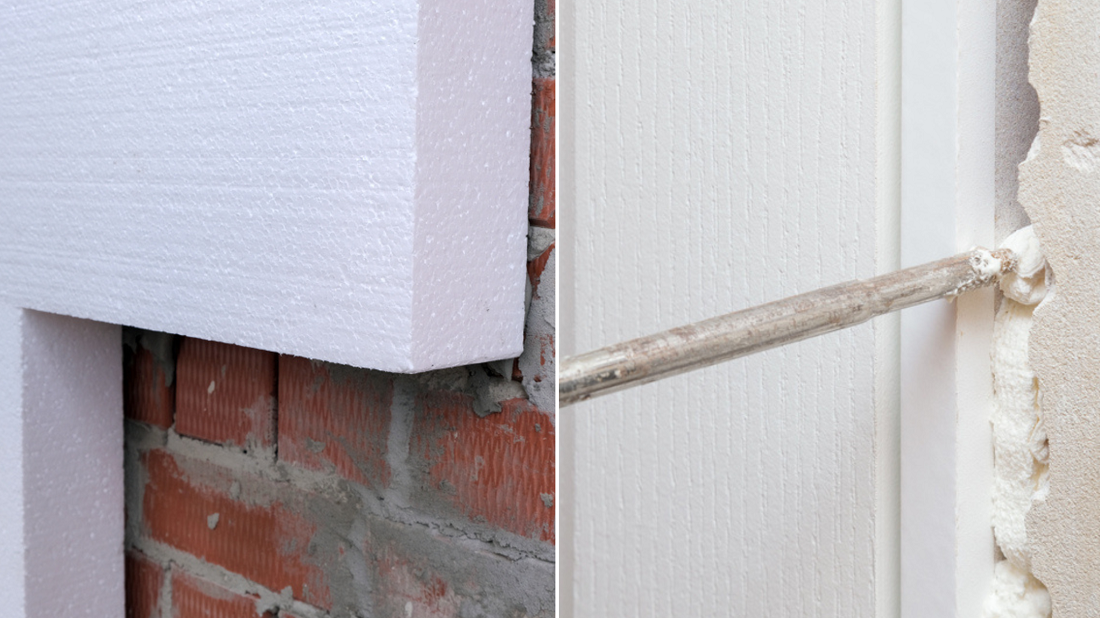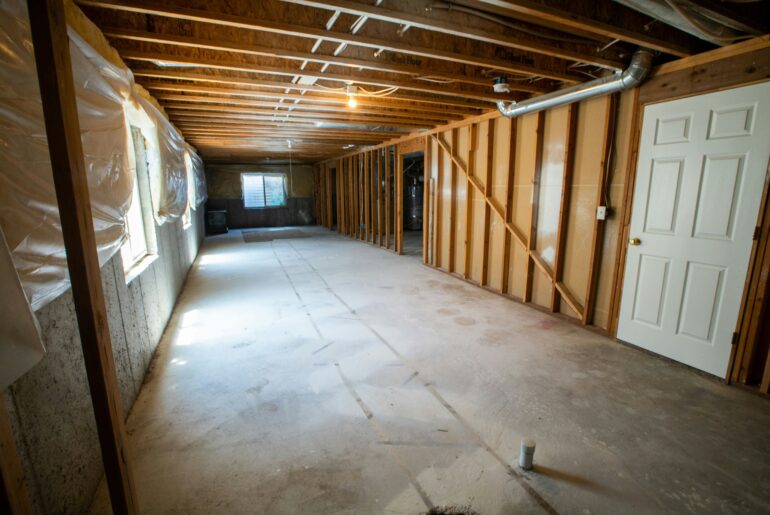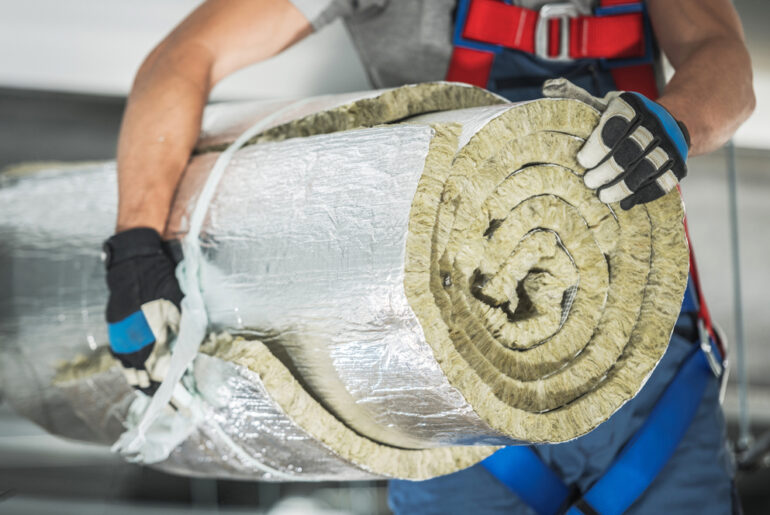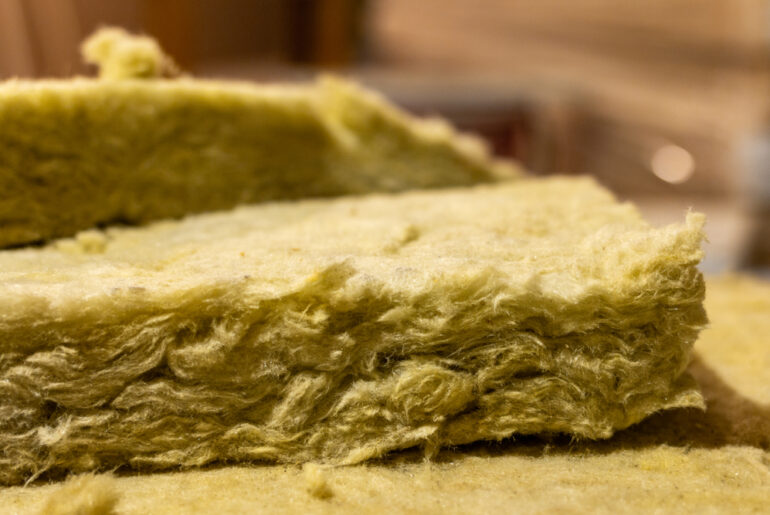Insulation is essential for the efficiency and comfort of the home. And if you’re planning on building a new home or upgrading existing insulation, you’ve probably come across foam insulation and its two types: spray foam and rigid foam.
Spray foam is a sealing and insulation product made from two chemical liquids that create expanding polyurethane foam and is applied using a spray gun. In contrast, Rigid foam is foam insulation made into solid panels.
While spray foam and rigid foam are both foam insulations, they have significant characteristic differences. To choose the right type of insulation for your home’s insulation needs, it’s important to learn all relevant information.
So, here’s a guide about everything you need to know about spray foam and rigid foam insulation—their basics, R-values, pros, cons, costs, and common applications.
Spray Foam Basics
Spray foam insulation is a sealing and insulation product made from two chemical liquids combined to create an expanding polyurethane foam. The two liquids, usually isocyanate and polyol resin, come from separate containers or hoppers commonly referred to as “A” and “B” sides.
These chemical components from different containers are transported using gas pressure, meeting at the tip of a spray gun where they react to each other and form the foam solution.
There are small pockets called “cells” within the foam solution that create air barriers and gaps. These cells make it difficult for sound and heat energy to pass through the foam as it dries in place. This makes the spray foam an effective and efficient insulator and sealing product.
There are two types of spray foam insulation: open-cell spray foam insulation and closed-cell spray foam insulation.
Spray foam insulation is commonly used as an air barrier and insulation, sealing walls, ceiling cavities, and floors. It’s also usually sprayed into an open cavity like rim joists, attics, crawl spaces, and even the small crannies and nooks in new construction. Even in existing structures, spray foam can be used around light fixtures, electrical outlets, and between windows and doors. As long as there are open cavities with access, spray foam insulation can be applied.
Advantages of spray foam:
- Excellent insulation coverage. Since spray foam insulation is installed through spraying and expands in place as it dries, it can reach and seal gaps, even tight corners and hard-to-reach corners, spaces, and open cavities.
- High energy efficiency. Spray foam insulation helps lower heating and cooling costs by preventing heat and cold from penetrating the thermal envelope. It also efficiently seals gaps, crevices, and small cracks because its expanding nature hinders air leaks and blocks water.
- Long-lasting. It’s resilient and durable because it’s not prone to settling over time and sagging, making it long-lasting. Spray foam also doesn’t break down and collect at the installed area’s bottom. Moreover, it creates a strong bond as it’s sticky once sprayed and dried.
- Reduced pollen, allergens, and other contaminants. Because spray foam reaches and seals the cracks and crevices, it prevents air from penetrating the walls, hence keeping the pollen, allergens, and other airborne contaminants inside the house. It also creates a barrier against pest intruders by filling the spaces with spray foam.
Disadvantages of spray foam:
- Expensive. Since spray foam insulation requires special equipment to mix and spray, it’s relatively more expensive than other insulation types. It also requires a professional installer, which adds to the cost.
- Known health risks. It includes chemicals like isocyanates that can cause eye, skin, and lung irritation when exposed. Long-term exposure to it can also aggravate asthma and bronchitis.
- Messy installation process. Installing spray foam insulation be messy as it’s sticky when wet yet dries quickly. The installation process also requires professional help as it has a particular installation process.
- Long curing time. It takes a few days for spray foam insulation to cure properly. In addition, it can produce unhealthy gas while wet.
Rigid Foam Basics
Rigid foam insulation is a foam insulation type made from dense foam sheets, commonly polyurethane, polystyrene, or Polyisocyanurate (polyiso). These polymers are melted, molded, and pressed to form sheets or panels. Due to the chemical structure, rigid foam is considered “closed-cell foam,” meaning its air-filled cells are sealed or enclosed and densely packed.
Rigid foam insulation is often sold as solid panels or sheets. It comes in different sizes and shapes, usually pre-made in 4-by-8-foot sheets. Moreover, it comes in different thicknesses ranging from ½ inch to 2 inches. The available densities also range from 33 to 60 kg/m3.
There are three common types of rigid foam insulation: Expanded Polystyrene Board (EPS), Extruded Polystyrene Board (XPS), and Polyisocyanurate (Polyiso, ISO).
Rigid board insulation is typically used as exterior insulation on wall exteriors, foundation walls, siding, and house wrap. It’s also an excellent option for kitchen areas, rim joists, roofs, attics, basements, and garages. However, rigid foam is not well-suited for irregular surfaces since it usually comes in sheets or boards.
Advantages of rigid foam:
- Excellent thermal protection. Rigid foam insulation provides a continuous seal that helps prevent air leaks and thermal bridging, preventing significant energy loss. It also has high R-values, commonly ranging from 3.6 to 8.0 per inch of thickness.
- Controls moisture. Rigid foam acts as a vapor barrier that prevents moisture accumulation. It also helps protect wood framing or sheathing from any contact with water and warms the interior sheathing so moisture does not accumulate
- Prevents air leaks. Rigid foam insulation is an excellent air barrier, especially when installed properly. It provides a continuous seal on the home’s exterior, preventing air leaks (infiltration and exfiltration).
- DIYable. It provides ease of installation as it doesn’t require special equipment and protection gears. Foam boards can be cut using a utility knife or fine saw. Moreover, rigid foam is an excellent DIY for homeowners as the process is not complex.
Disadvantages Of rigid foam:
- Requires proper installation. Although rigid foam doesn’t require special equipment, it has strict installation and sealing code procedures to meet. It must be properly installed to act as a weather-resistive barrier and limit air leaks.
- Requires precision. Rigid foam boards must be custom-cut to fit the installation area. It’s also difficult to fit around wall obstructions, such as pipes, wires, outlets, bracing, and junction boxes. This is why it must be carefully cut to work around such obstacles.
- Gaps. Since it’s difficult to fit around the obstruction and get a tight seal, caulking or expandable foam must fill and seal thin gaps between the framing members and foam.
R-Value Comparison: Spray Foam vs Rigid Foam
The R-values of spray foam insulation may depend on the type of spray foam used. For example, open-cell spray foam approximately has an R-value of 3.8 per inch, while closed-cell spray foam has an R-value of about 6 to 7 per inch.
Rigid foam insulation’s R-value also depends on the type of foam board used with R-values ranging from 3.6 to 8.0 per inch of thickness, on average.
Expanded Polystyrene Board (EPS) has an average R-Value of about 3.6 to 4.2 per inch, while Expanded Polystyrene Board (EPS) offers an R-Value of about 5 per inch. In contrast, Polyisocyanurate иoard “polyiso” provides an average R-value of 6.5 to R-8 per inch. In addition, a facing material can also be applied to the rigid foam insulation, which can greatly affect the R-value of the material.
Rigid foam insulation has higher R-values than spray foam insulation, meaning it is more efficient in preventing heat transfer.
Cost Comparison: Spray Foam vs Rigid Foam
On average, spray foam insulation installation is applied in 1-inch-thick layers. Open-cell spray foam averages $0.44 to $0.6 per board foot, while closed-cell spray foam ranges from $1.00 to $1.50 per board foot.
It also has labor fees, ranging from $50 to $100 per hour, depending on the job’s complexity, size, and location. Depending on the state, installing a vapor barrier may also be required by code. It usually costs around $0.65 to $1 per square foot.
In general, spray foam insulation costs between $1,300 and $3,900, including labor fees and other materials.
The foam board itself costs around $0.25 to $1.40 per square foot for rigid foam insulation. EPS boards range from $0.25 to $0.35, while XPS boards range from $0.40 to $0.50. Polyiso boards cost around $0.50 to $1.40.
It also includes the installation fees, which are about $25 to $50 per 100 square feet, depending on the location. The total costs of rigid foam insulation installation range from $2,500 and $7,500.
Therefore, spray foam insulation is much cheaper regarding costs than rigid foam insulation.
Installation Process Comparison: Spray Foam vs Rigid Foam
Spray foam insulation is applied through a spraying machine, where two chemical components from different containers will be transported using gas pressure and will meet at the tip of the spray gun, where they react with each other and form the foam solution.
Spray foam can be applied to hard-to-reach places and cavities, such as rim joists, attics, crawl spaces, and even small crannies and nooks. However, it can be messy and time-consuming because of the curing period. It’s also temperature-sensitive and can affect the curing process.
Before filling the cavity, spray the perimeter with a 1/2-inch layer called lifts first. This will expand to a 1-in. layer. Wait a few minutes as the foam needs to cure before applying another lift. Next, spray more than 2 inches thick, ensuring all gaps and holes are filled. Trim off excess foam with a serrated knife after it’s cured if you overfill an area.
When installing rigid foam insulation, you must first calk all the seams with silicone caulk and then spray foam into larger holes.
Next, measure the installation area and custom cut the foam boards using a knife or fine saw into measurements to fit, especially into obstructions. After cutting, break it off cleanly and apply adhesive to the rigid foam panel’s back. Then, place the rigid foam panel and push it firmly. Continue to install the rigid foam panels, ensuring all obstructions and holes are caulked and sealed.
As a result, rigid foam insulation provides an easier installation process than spray foam insulation because it can be installed by itself without special equipment and a long curing period.
Safety Comparison: Spray Foam vs Rigid Foam
Spray foam insulation contains chemicals like isocyanates that can harm a person’s health and cause eye, skin, and lung irritation when exposed. Wearing protective gear is also needed when installing this type of insulation.
On the other hand, rigid foam insulation is clean and irritant-free and doesn’t need any protective gear aside from a dust mask when installation.
This makes rigid foam insulation safer to use than spray foam insulation.
Longevity: Spray Foam vs Rigid Foam
Spray foam insulation usually lasts 80 to 100 years with little to no maintenance. It also doesn’t settle, sag, or deteriorate.
In contrast, rigid foam insulation may last 100 years or more. However, proper installation is key, and regular maintenance is essential.
Therefore, Spray foam insulation is better in terms of longevity as it’s long-lasting and doesn’t require maintenance.
Common Applications
Basement
Rigid foam boards are great for insulating basement walls as it works well with flat and smooth block or concrete walls. It’s also easy to use and install before framing the walls.
Using spray foam, especially closed-cell spray foam, is an excellent way to insulate and seal basement walls as it provides a high R-value and excellent moisture resistance, with less thickness required. In addition, it can fill in all the gaps and spaces, giving you the best protection against moisture and air infiltration. This makes spray foam insulation the preferred type in basements.
Attic
Rigid foam is an excellent insulation choice for attics as it’s lightweight and easy to work with. Although it usually needs to be combined with batts insulation.
Insulating attics with spray foam insulation provides thermal and vapor-control layers that create a conditioned space. It doesn’t take much space, filling and sealing gaps and open cavities. It also works well around obstructions like pipes and wiring.
As a result, spray foam is the preferred insulation type when installed in attics.
Garage
Rigid foam is best for insulating garage doors and thin walls. It provides a high R-value, great noise reduction, and is an affordable option. However, the rigid foam must be covered with plywood or other subfloor material when insulating the floor.
Spray foam insulation works best for converting garages to living spaces as it provides an airtight seal, has a high R-value, and is mold and insect-resistant.
Spray foam is much more costly, which is why rigid foam insulation works best for garages.
Crawl Space
Using spray foam insulation for crawl spaces will act as a thermal, air, and gas barrier between this and the main living area above, filling crevices, cracks, and gaps. It’s also best used in the joist box, the crawl space’s weakest point.
Rigid foam insulation is best installed against the foundation walls of the crawl space, as it inhibits mold, prevents air leaks, and doesn’t absorb water. It will also help the floors above warmer for bare feet in winter. This makes rigid foam insulation a preferred choice for craw spaces.
Interior Walls
Spray foam is commonly used to insulate existing house walls without removing drywall. Rigid foam can also be used to insulate interior walls and can be effectively combined with other insulation materials such as fiberglass batts.
Is Spray Foam Better That Rigid Foam?
Overall, spray foam is better than rigid foam insulation as it has a higher R-value and excellent coverage. In addition, this efficiently fills and seals hard-to-reach places, gaps, crevices, and small cracks because its expanding nature hinders air leaks and blocks water. Spray foam also is more long-lasting as it doesn’t settle, sag, or deteriorate.
In contrast, rigid foam board insulation has excellent thermal protection, mold, and mildew resistance but has a lower R-value. It also can be difficult to install in areas with obstructions and must be cut to fit. Although rigid foam insulation is less expensive than spray foam, spray foam’s benefits outweigh rigid foam’s.
Comparison Table: Rigid Foam vs Spray Foam
| Insulation | R-Value(per inch) | Types | Costs | Common Applications |
| Spray foam | 3.8 to 7 per inch of thickness | Open-cell spray foam Closed-cell spray foam | $0.44 to $1.50 per board foot Total $1,300 to $3,900 | Walls Ceiling cavities, Floors Rim joists, Attics Crawl spaces Around light fixtures Electrical outlets Windows and doors. |
| Rigid foam | 3.6 to 8 per inch of thickness | Expanded Polystyrene Board (EPS) Extruded Polystyrene Board (XPS) Polyisocyanurate (Polyiso, ISO) | $0.25 to $0.35 $0.40 to $0.50 $0.70 to $0.50 Total $2,500 to $7,500 | Wall exteriors Foundation wallsSidingHouse wrap Kitchen areas Rim joists Roofs Attics Basements Garages |





